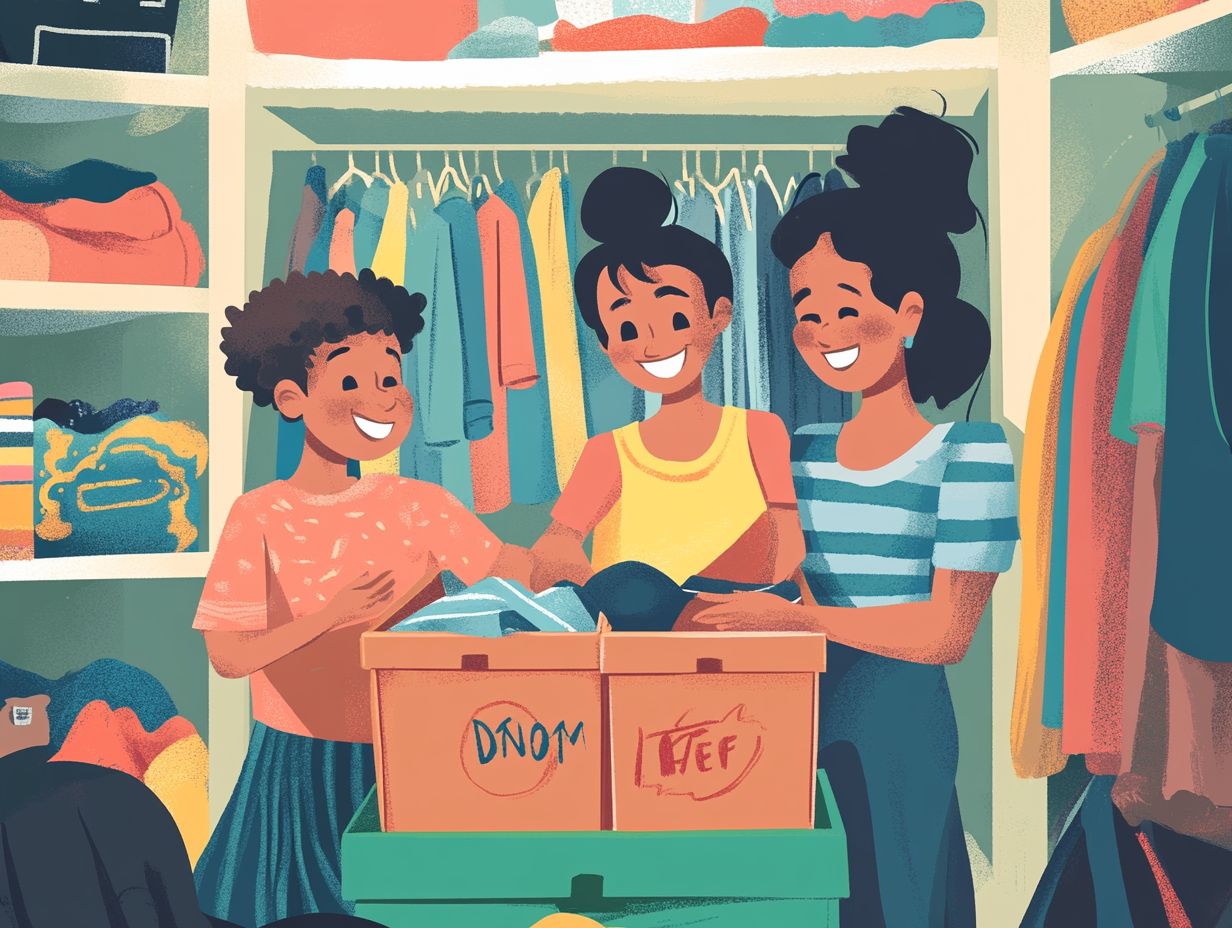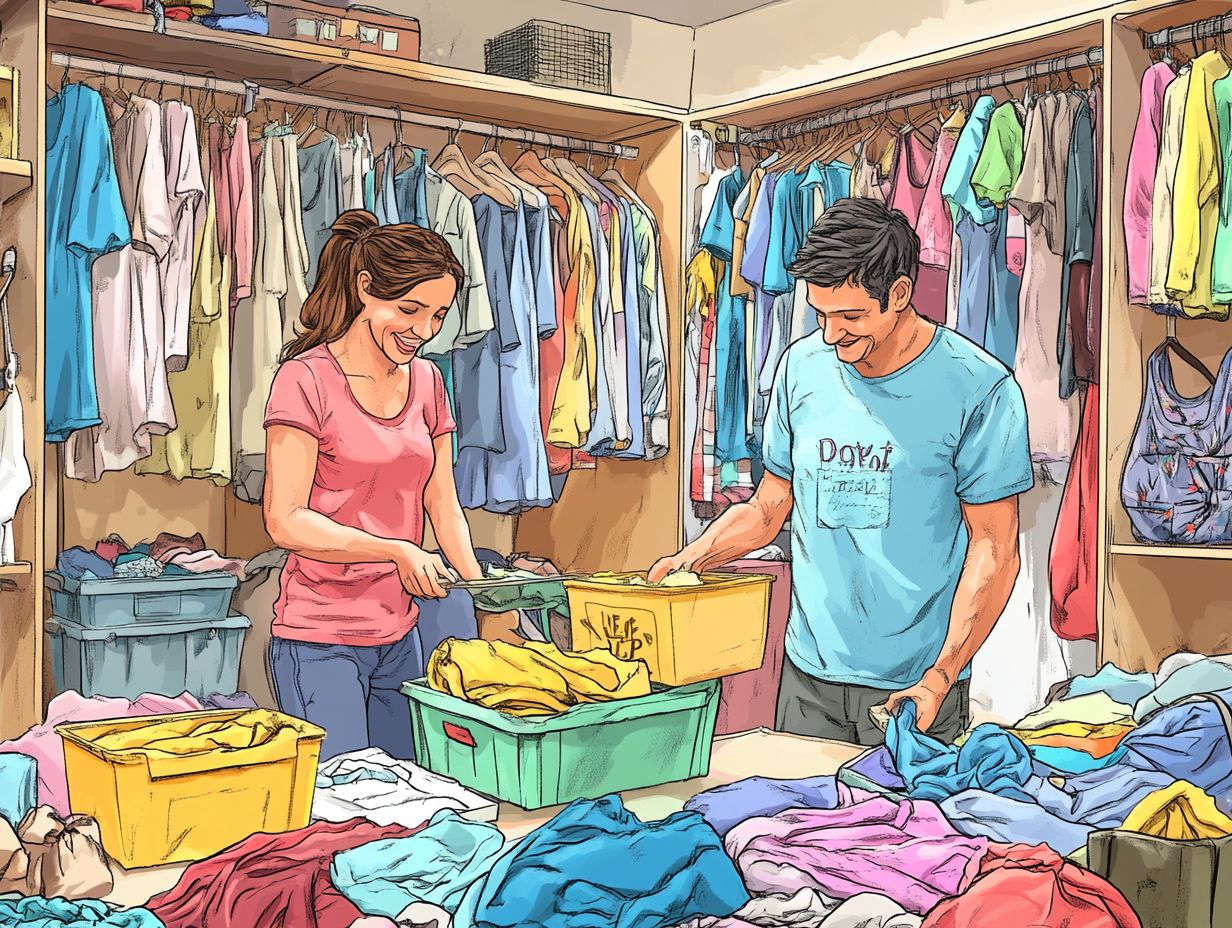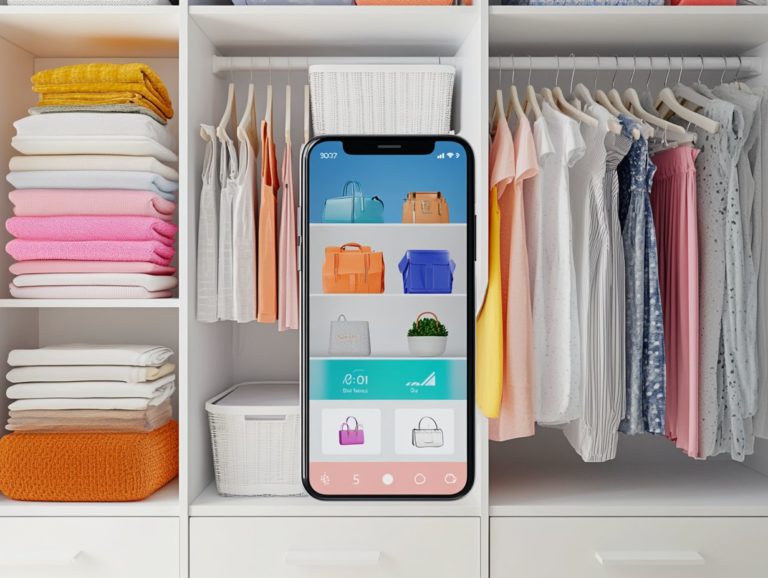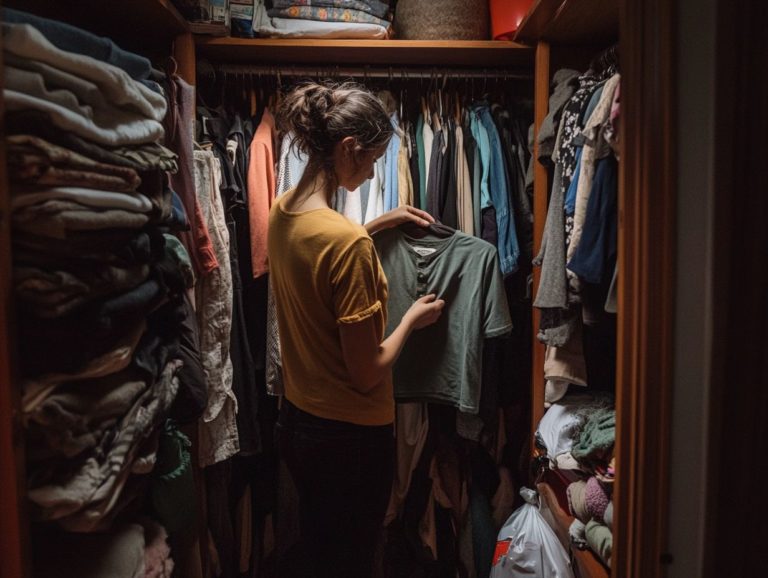How to Get Family Involved in Closet Decluttering
Decluttering isn’t solely a solo endeavor; it can evolve into a transformative family activity that fosters connection among everyone involved. This exploration reveals the myriad benefits of decluttering as a family, ranging from cultivating a more organized home to enhancing teamwork and communication.
Get ready to dive into fun tips that will inspire your family! You ll also find a step-by-step guide for tackling clutter and strategies to sustain that momentum.
Common challenges are thoughtfully addressed, along with effective solutions to overcome any resistance. Prepare to embark on a journey toward a more harmonious living space!
Contents
- Key Takeaways:
- The Importance of Decluttering as a Family
- Benefits for Everyone
- Getting Started: Tips for Motivating Your Family
- Step-by-Step Guide to Decluttering as a Family
- Keeping the Momentum Going
- Dealing with Resistance and Conflict
- Frequently Asked Questions
- 1. How can I get my family involved in closet decluttering?
- 2. What are some fun ways to make closet decluttering a family activity?
- 3. How do I convince my family to part with sentimental items?
- 4. What should I do if my family is resistant to decluttering?
- 5. How often should we declutter our closets?
- 6. How can we maintain a clutter-free closet?
Key Takeaways:

- Involve the whole family in decluttering to reap the benefits of a clean and organized space for everyone.
- Motivate your family by creating a positive attitude towards decluttering and setting specific goals and tasks for each member.
- Maintain a decluttered space by regularly tidying up and dealing with any resistance or conflict that may arise.
The Importance of Decluttering as a Family
Decluttering as a family not only creates a serene, clutter-free environment but also enhances communication and strengthens the bonds among family members. It transforms the process into a shared responsibility, elevating it beyond a solitary task.
When you engage in decluttering activities together, you re not just clearing out physical spaces; you re building patience and understanding. This collaboration turns potential tension into relaxed conversations about values, possessions, and priorities.
This shared journey can seamlessly evolve into a cherished family tradition that underscores the significance of organization and emotional well-being. Ultimately, it leads to a more harmonious living space and a closer family unit.
Benefits for Everyone
Decluttering offers remarkable benefits for everyone in the family. It fosters a sense of ownership, responsibility, and teamwork, transforming your home into a more organized and peaceful sanctuary.
As you tackle clutter together, both kids and adults develop invaluable life skills like decision-making and collaboration. This enhances emotional well-being along the way. For children, a clutter-free space sparks focus and creativity, allowing them to dive into play and learning activities with renewed enthusiasm.
Adults often find their stress levels significantly reduced as they navigate daily responsibilities within a tidy, harmonious environment. Start organizing today to streamline your living space!
This collective effort strengthens family bonds, as each member supports and motivates one another throughout the decluttering journey. What may initially seem like a daunting task can become a rewarding opportunity for deepening connections and celebrating collective achievements, especially when using resources like the 5-step closet decluttering checklist.
Getting Started: Tips for Motivating Your Family
Motivating your family to embark on a decluttering journey can be a truly rewarding experience when approached with thoughtful strategies. By creating an environment that inspires participation, you can turn decluttering into a collective challenge everyone is eager to join.
Start by introducing automatic habits that ease the transition, such as instituting a shopping pause a break from shopping to avoid adding more items to your home. Establishing a cleaning routine that includes regular decluttering sessions can also work wonders.
This allows family members to gradually adopt a clutter-free lifestyle and fosters a shared commitment to maintaining a harmonious living space.
Creating a Positive Attitude Towards Decluttering

Creating a positive attitude toward decluttering begins with open communication among family members. This allows everyone to express their feelings about possessions and the emotions tied to clutter.
Such dialogue lays the groundwork for a supportive environment, where each individual feels valued and heard. When family dynamics foster the sharing of diverse perspectives, addressing the emotional challenges of clutter becomes simpler. By discussing their attachments to various items, family members can help one another distinguish between sentimental value and needless accumulation. They can also learn how to make the most of a decluttered closet in the process.
Incorporating regular family meetings focused on decluttering strengthens relationships and cultivates a sense of teamwork. This collaborative approach can transform the often daunting task of tidying up into a shared goal, promoting the development of healthier habits and a more harmonious living space. For those looking for strategies, a step-by-step guide to closet decluttering can be incredibly helpful.
Step-by-Step Guide to Decluttering as a Family
A step-by-step guide to decluttering as a family requires strategic planning. Setting clear goals and assigning specific tasks can pave the way for a successful transition to a clutter-free home.
Begin by pinpointing the areas that need the most attention. Establish a timeline for your decluttering sessions.
Involving everyone in the process is crucial. Let each family member take ownership of specific tasks, whether it’s sorting through toys, clothes, or household items. This collaborative approach fosters a sense of community and highlights the shared responsibility of maintaining a clean and organized environment. For example, teaching your family how to maintain a decluttered closet can be a valuable part of this process.
Setting Goals and Assigning Tasks
Setting clear goals and assigning tasks are essential steps in your decluttering journey. This ensures that each family member understands their role in creating a clutter-free home.
Start by outlining specific and measurable objectives, like aiming to reduce the number of items in a particular room by a set percentage within a month. This method establishes a clear target and fosters a sense of accountability among everyone involved.
Consider each family member’s unique strengths and interests when distributing tasks. For example, someone with a knack for organizing could take on the storage areas, while another who thrives on creativity might enjoy curating decor items for donation.
By harnessing these individual abilities, your family can collaborate efficiently towards a shared vision of a more organized living space.
Keeping the Momentum Going
Maintaining momentum after your initial decluttering efforts is crucial for preserving a tidy space and nurturing lasting clutter-free habits among your family. Establishing consistent cleaning routines reinforces the organization strategies you ve implemented, ensuring that clutter doesn t make a sneaky return to your home.
Regular family check-ins provide valuable opportunities to evaluate the condition of your spaces and adjust your strategies as necessary. This proactive approach emphasizes teamwork and fosters a sense of accountability, making it easier for everyone to contribute to a harmonious living environment. Incorporating tips for decluttering your closet with kids can further enhance this process.
How to Maintain a Decluttered Space

To maintain a decluttered space, incorporating automatic habits and effective communication techniques simplifies the process for your entire family.
Establish consistent daily routines, like dedicating just 10 minutes each evening to tidy up shared spaces. This creates a sense of collective responsibility among all household members. For those looking to enhance their tidying efforts, consider how to set goals for your closet decluttering.
Fostering open discussions about clutter encourages each individual to express their thoughts and priorities regarding shared areas, nurturing a spirit of teamwork. This approach helps identify areas that need attention and cultivates a culture of mindfulness about belongings, making it easier to engage with how to make decluttering a family activity.
Integrating simple checklists or visual reminders keeps everyone accountable and engaged. This transforms the journey into a collaborative effort that fosters harmony and satisfaction in maintaining a clutter-free environment.
Dealing with Resistance and Conflict
Facing resistance and conflict during decluttering is completely normal. Use effective strategies to turn these challenges into valuable opportunities for growth.
Strategies for Overcoming Obstacles
Effective strategies can enhance family dynamics and promote constructive communication.
Often, family members have different opinions on what to keep or discard. Create an open dialogue where everyone can share their thoughts without fear of judgment.
Establish categories like ‘Sentimental,’ ‘Donate,’ and ‘Trash’ to systematically evaluate each item. Use a timer for quick sessions to alleviate feelings of overwhelm.
A collaborative atmosphere helps your family navigate the emotional challenges of decluttering together, reinforcing bonds and achieving a clutter-free home.
Frequently Asked Questions
1. How can I get my family involved in closet decluttering?

Explain how decluttering creates more space and reduces stress. Set up a donation pile for unwanted items and assign tasks to each family member.
2. What are some fun ways to make closet decluttering a family activity?
Make decluttering a game! Set a timer and see who can declutter the most items within that time. Alternatively, create a “keep, donate, toss” system and race to sort items.
3. How do I convince my family to part with sentimental items?
Remind everyone that keeping too many items leads to clutter. Suggest taking photos of sentimental items to preserve memories without the physical clutter.
4. What should I do if my family is resistant to decluttering?
Start small by focusing on one area, like the garage. This approach helps reduce feelings of overwhelm and shows the benefits of decluttering.
Offer to help declutter or donate unwanted items on their behalf to a local charity.
5. How often should we declutter our closets?
It s best to declutter at least twice a year, typically at the start of each season. This helps you reassess your wardrobe and let go of items you no longer need.
6. How can we maintain a clutter-free closet?
Create an organizing system using bins or baskets for different categories like shoes or toys. Encourage everyone to return items to their designated spots after use.






